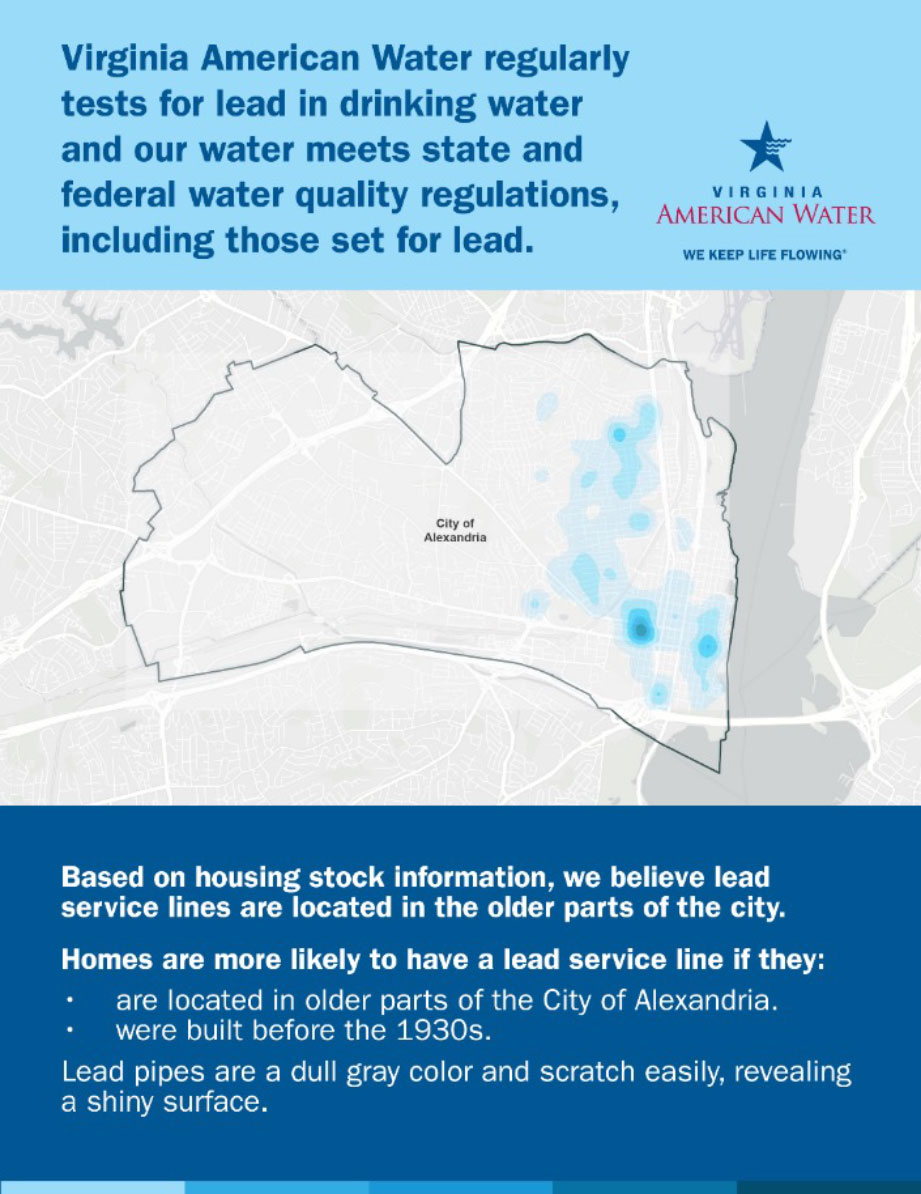Alexandria LSLR Program
Virginia American Water is working to remove all instances of lead from our Alexandria water distribution system. Review the below Questions/Answers to learn more about your water service and lead and details about our replacement program.
Frequently asked questions about Virginia American Water's LSLR Program:
No. VAWC’s water mains are not made of lead; however, the water service line that carries the water from the water main in the street to your home could be. Homeowners’ service lines may be made of lead, copper, galvanized steel or plastic.
Yes and yes. The EPA’s lead standard is an action level that requires treatment modifications if lead test results exceed 15 parts per billion (ppb) in more than 10 percent of first draw samples taken from household taps.
While Virginia American Water owns and operates the drinking water distribution system in Alexandria, we buy the water already treated from Fairfax Water. Fairfax Water adds a corrosion inhibitor to help prevent lead from leaching into drinking water.
Virginia American Water regularly conducts tests in our Alexandria distribution system in accordance with the EPA regulatory requirements. For more information on your system, visit virginaamwater.com to view the latest consumer confidence report. Under the Water Quality menu, select Water Quality Reports, the select Alexandria.
In 2018, there were approximately 2,641 utility-owned service lines identified as either potentially lead, unknown or presumed lead in the City of Alexandria. Since 2018, we have reduced that number by 25%. Our records indicate that statewide, only about 3% of Virginia American Water’s service lines contain lead. Virginia American Water does not maintain records regarding the type of material of customer-owned service lines.

Yes, in conjunction with our water main replacement activities in Alexandria. We notify our customers beforehand by mailing postcards, informational packets and in-person contact during our asset replacement projects. As we replace the utility-owned service lines, we will work with the customer to assess their side and if it is determined to contain lead, we will replace their portion with their agreement.
It is important to understand that their water meets state and federal standards, including those set for lead, and is safe to consume. Even if they do have a lead service line, the water is treated by our bulk water supplier, Fairfax Water, with a corrosion inhibitor to help prevent lead from leaching into drinking water.
Most commonly, we see service lines made out of copper, galvanized steel, plastic/PVC or lead. There are simple ways that you can assess your home’s customer-owned service line by following these steps to assess.
YOU WILL NEED: Key or coin and a strong magnet
WHAT TO DO:
1. Locate the service line pipe as it enters your home from an exterior wall.
2. Carefully scratch the pipe (like you would a lottery ticket) with a key or coin.
Take care not to make a hole in the pipe. If the scratch turns a shiny silver
color, it could be lead or steel. NOTE: If a pipe is painted, use sandpaper to
expose the metal.
3. Place the strong magnet on the pipe. If a magnet sticks, it is a steel pipe.

The need for a home treatment device is a customer-specific decision. The need for a home treatment device is a customer decision. If you choose to purchase a home filter, NSF International created a Consumer Guide to NSF Certified Lead Filtration Devices for Reduction of Lead in Drinking Water. For more information, visit www.nsf.org/info/leadfiltrationguide. Always consult the device manufacturer for information on treatment device maintenance and potential impacts to your drinking water or household plumbing.
While using filters rated to remove lead (as listed above) can be effective if properly maintained, removing the entire lead service line will remove a source of lead and help to minimize your risk of potential exposure to lead in drinking water.
At this time, this program is only offered when we are upgrading our water infrastructure. Customers always have the option of replacing their portion of the service line through their own contractor at their own expense, not reimbursed by the company. If you decide to replace your service line prior to work on your street, it’s very important for you and/or your plumber to contact us ahead of time.
